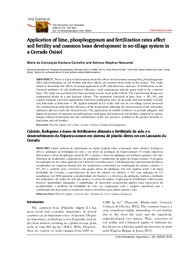Application of lime, phosphogypsum and fertilization rates affect soil fertility and common bean development in no-tillage system in a Cerrado Oxisol.
Application of lime, phosphogypsum and fertilization rates affect soil fertility and common bean development in no-tillage system in a Cerrado Oxisol.
Author(s): CARVALHO, M. da C. S.; NASCENTE, A. S.
Summary: There is a lack of information about the effects of interactions among lime, phosphogypsum (PG) and fertilization on soil fertility and their effects on common bean yields in the tropics. This study aimed to determine the effects of annual application of PG and limestone and rates of fertilization on the chemical attributes of soil, fertilization efficiency , yield components and the grain yield of the common bean. The study was performed for three growing seasons in an acidic Oxisol. The experimental design was randomized blocks in a 4x4 factorial scheme. The treatments consisted of lime, lime + PG, PG, and control (without corrective application) with four fertilization rates. In an acidic and low-fertility Cerrado soil, limestone or limestone + PG applied annually at 1/3 of the total rate in a no tillage system increased the common bean yield and the efficiency of the fertilization, although the improvement of the soil acidity indicators did not reach the desired levels. The application of soluble fertilizers to provide adequate and balanced amounts of nutrients provided greater yield gains and improved soil fertility compared to surface liming without fertilization, but the combination of the two practices resulted in the greatest benefits to both plant and soil fertility.
Publication year: 2018
Types of publication: Journal article
Unit: Embrapa Rice & Beans
Observation
Some of Embrapa's publications are published as ePub files. To read them, use or download one of the following free software options to your computer or mobile device. Android: Google Play Books; IOS: iBooks; Windows and Linux: Calibre.
Access other publications
Access the Agricultural Research Database (BDPA) to consult Embrapa's full library collection and records.
Visit Embrapa Bookstore to purchase books and other publications sold by Embrapa.

